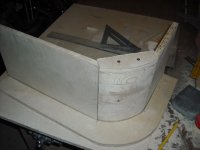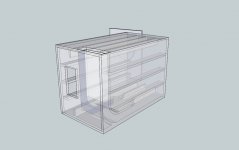Hi DIY'ers,
I'm making a subwoofer box and due to my square ports are a bit too long for the box dimensions intended, I'm considering making a 90 degree bend, but does that effect the tuning of the box?
If so, how do I calculate the dimensions for the new port?
Regards,
Simon H.A.
I'm making a subwoofer box and due to my square ports are a bit too long for the box dimensions intended, I'm considering making a 90 degree bend, but does that effect the tuning of the box?
If so, how do I calculate the dimensions for the new port?
Regards,
Simon H.A.
I'll probably go down in a blaze for this-just measure down the centre of the port and the bend shouldn't make any real difference-but I only have basic modeling software, so can't get any different tuning that might occur to model..
Okay, I have a box right now with normal straight ports, so I can compare it to the new box when I've made it. Guess I'll just will go for the try.
Regards,
Simon H.A.
Regards,
Simon H.A.
So long as your port area is adequate enough, the center length measurement should be accurate. If port velocity is too high, you'll get chuffing and a corresponding loss of SPL.
I would check the tuning with a resistor load - generator - voltmeter. Adjust the port length as necessary.
My port velocity is not too high (according to WinISD), so it shouldn't be a problem. I think I will test the enclosure in a sound dead room that we have at my high school.
Thanks for your responses.
Regards,
Simon H.A.
Thanks for your responses.
Regards,
Simon H.A.
Port velocity is a separate issue from tuning (Fb).My port velocity is not too high (according to WinISD), so it shouldn't be a problem.
You can easily check the port tuning by eye, put a dot on the cone and play sine wave tones through the cabinet, the cone will have least movement at Fb.
Always best to go a little long on the port length, you can cut it down if Fb is lower than you want.
The 90 degree bend will probably lower the tuning a bit from what it would be if it were straight.
Never heard of the dot method.
Agree with the bend lowering the tuning, but the size and lenght of the "L" would also.
Agree with the bend lowering the tuning, but the size and lenght of the "L" would also.
Oh good grief, DON'T bend the port! 
Just think about it-how is fast-moving air at high pressure going to turn that corner? That's right, not very well at all!! 😱
I do not understand why people do this, it is common sense that it's just dumb. Of course it will work and make some kind of output. At moderate SPL it might even work OK. At high SPL it will become turbulent, or as Nokia's Juha Backman put it, "relatively small irregularities can increase the nonlinearity greatly."
Methinks a 90 degree bend would qualify as an "irregularity" 😛
You'd be better off with a smaller port that at least would flow more linearly.
There are good papers about ports, but I don't know a free source offhand
Loudspeaker Ports
Author: Vanderkooy, John
AES E-Library Loudspeaker Ports
The Nonlinear Behavior of Reflex Ports
Author: Backman, Juha
AES E-Library The Nonlinear Behavior of Reflex Ports
Maximizing Performance from Loudspeaker Ports
Authors: Salvatti, Alex; Button, Doug; Devantier, Alan
AES E-Library Maximizing Performance from Loudspeaker Ports

Just think about it-how is fast-moving air at high pressure going to turn that corner? That's right, not very well at all!! 😱
I do not understand why people do this, it is common sense that it's just dumb. Of course it will work and make some kind of output. At moderate SPL it might even work OK. At high SPL it will become turbulent, or as Nokia's Juha Backman put it, "relatively small irregularities can increase the nonlinearity greatly."
Methinks a 90 degree bend would qualify as an "irregularity" 😛
You'd be better off with a smaller port that at least would flow more linearly.
There are good papers about ports, but I don't know a free source offhand
Loudspeaker Ports
Author: Vanderkooy, John
AES E-Library Loudspeaker Ports
The Nonlinear Behavior of Reflex Ports
Author: Backman, Juha
AES E-Library The Nonlinear Behavior of Reflex Ports
Maximizing Performance from Loudspeaker Ports
Authors: Salvatti, Alex; Button, Doug; Devantier, Alan
AES E-Library Maximizing Performance from Loudspeaker Ports
A suggested bent shelf type vent method.

A typical 4" ID schedule 40 PVC 90° elbow acts like it is about 9" long (terminated flush on the front panel).

A typical 4" ID schedule 40 PVC 90° elbow acts like it is about 9" long (terminated flush on the front panel).
"You'd be better off with a smaller port that at least would flow more linearly. "
I disagree.
The JBL 4311 (L100) studio monitor uses a 3" ID port with a 90° elbow, a smaller port (that would fit the box without bending) would have 'chuffed' horribly.
Air flow in ports is non-linear with changes in volume anyway. Examining the shift in tuning frequency between small signal and maximum output can show a difference in Fb of 10% in some designs.
I disagree.
The JBL 4311 (L100) studio monitor uses a 3" ID port with a 90° elbow, a smaller port (that would fit the box without bending) would have 'chuffed' horribly.
Air flow in ports is non-linear with changes in volume anyway. Examining the shift in tuning frequency between small signal and maximum output can show a difference in Fb of 10% in some designs.
Last edited:
Where do I find formulas on the bent shelf type? And for your information the maximum output will be 105 dB @ 45 watt, so it isn't a high power system.
Regards,
Simon H.A.
Regards,
Simon H.A.
As long as the port is not designed to have high velocity (faster than 15m/s) a bend will not do much to the wave flow.
the pic is a design for a 12" sub with 14mm Xmax that is tuned to ~15hz and 14m/s max at full output. the bend does nothing to the output when compared to a strait port of the same dimensions.
design the port right and it won't matter.
the pic is a design for a 12" sub with 14mm Xmax that is tuned to ~15hz and 14m/s max at full output. the bend does nothing to the output when compared to a strait port of the same dimensions.
design the port right and it won't matter.
Attachments
Nice work.
Two 45° as per my drawing are very easy, and give similar performance. Probably not quite as good as yours, which looks similar to the original BIC Venturi ports.
Two 45° as per my drawing are very easy, and give similar performance. Probably not quite as good as yours, which looks similar to the original BIC Venturi ports.
Thought I might pipe in here.....
some may not know but there are "longer" 90 degee PVC fittings; vs., short 90s.
E.G., Sweep - Street - Long - Bow
Search Results - PexSupply.com
some may not know but there are "longer" 90 degee PVC fittings; vs., short 90s.
E.G., Sweep - Street - Long - Bow
Search Results - PexSupply.com
I'd much rather have 90 or even 180 degree bends to make up a port, ideally with some mild treatments to "smooth" out harsh angles, than a port that is too small.
The only issue is that, when the port size gets really big and long to deal with those low Vas low Fs drivers, simulation in programs like WinISD likely starts to get inaccurate. Better to use hornresp or TL worksheets or something else to come up with a more reliable sim.
Eric
The only issue is that, when the port size gets really big and long to deal with those low Vas low Fs drivers, simulation in programs like WinISD likely starts to get inaccurate. Better to use hornresp or TL worksheets or something else to come up with a more reliable sim.
Eric
- Status
- Not open for further replies.
- Home
- Loudspeakers
- Subwoofers
- Port calculations - 90 degree bend


